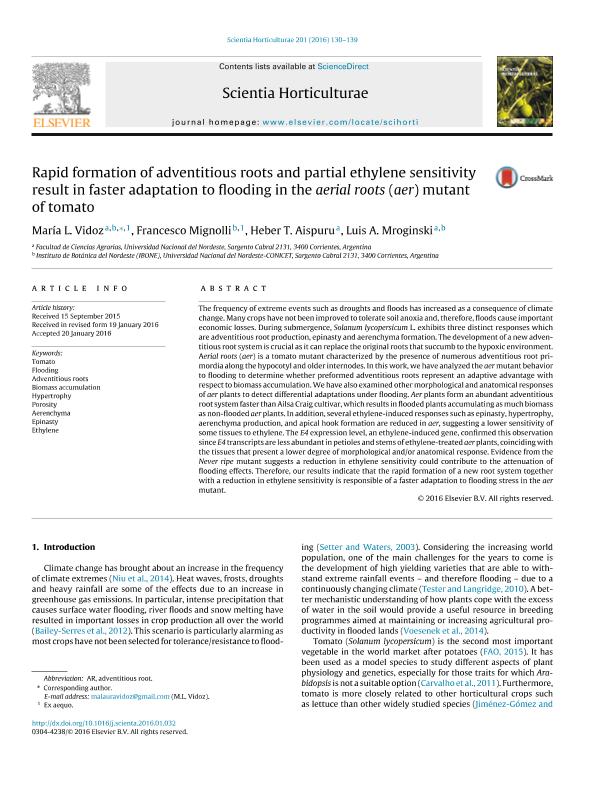Artículo
Rapid formation of adventitious roots and partial ethylene sensitivity result in faster adaptation to flooding in the aerial roots (aer) mutant of tomato
Fecha de publicación:
03/2016
Editorial:
Elsevier Science
Revista:
Scientia Horticulturae
ISSN:
0304-4238
Idioma:
Inglés
Tipo de recurso:
Artículo publicado
Clasificación temática:
Resumen
The frequency of extreme events such as droughts and floods has increased as a consequence of climate change. Many crops have not been improved to tolerate soil anoxia and, therefore, floods cause important economic losses. During submergence, Solanum lycopersicum exhibits three distinct responses which are adventitious root production, epinasty and aerenchyma formation. The development of a new adventitious root system is crucial as it can replace the original roots that succumb to the hypoxic environment. Aerial roots (aer) is a tomato mutant characterized by the presence of numerous adventitious root primordia along the hypocotyl and older internodes. In this work, we have analyzed the aer mutant behavior to flooding to determine whether preformed adventitious roots represent an adaptive advantage with respect to biomass accumulation. We have also examined other morphological and anatomical responses of aer plants to determine differential adaptations under flooding. Aer plants form an abundant adventitious root system faster than AC, which results in flooded plants accumulating as much biomass as non-flooded aer plants. It appears that, several ethylene-induced responses such as epinasty, hypertrophy, aerenchyma production, and apical hook formation are reduced in aer, suggesting a lower sensitivity of some tissues to ethylene. The E4 expression level, an ethylene-induced gene, confirmed this observation since E4 transcripts are less abundant in petioles and stems of ethylene-treated aer plants, coinciding with the tissues that presented a lower degree of morphological and/or anatomical response. Evidence from the Never ripe mutant suggests a reduction in ethylene sensitivity could contribute to the attenuation of flooding effects. Therefore, our results indicate that the rapid formation of a new root system together with a reduction in ethylene sensitivity is responsible of a faster adaptation to flooding stress in the aer mutant.
Archivos asociados
Licencia
Identificadores
Colecciones
Articulos(IBONE)
Articulos de INST.DE BOTANICA DEL NORDESTE (I)
Articulos de INST.DE BOTANICA DEL NORDESTE (I)
Citación
Vidoz, María Laura; Mignolli, Francesco; Aispuru, Heber T.; Mroginski, Luis Amado; Rapid formation of adventitious roots and partial ethylene sensitivity result in faster adaptation to flooding in the aerial roots (aer) mutant of tomato; Elsevier Science; Scientia Horticulturae; 201; 3-2016; 130-139
Compartir
Altmétricas




